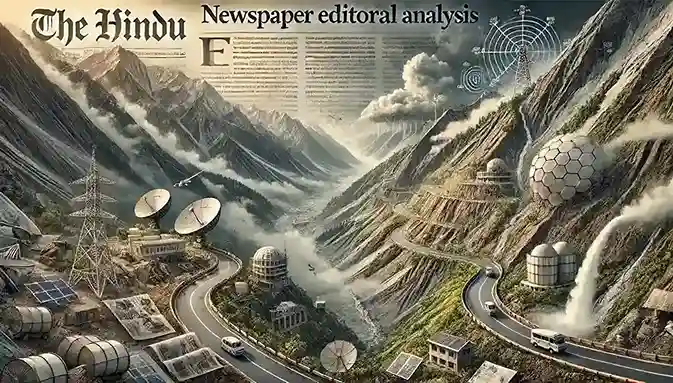Analysis of The Hindu Editorial 1: A perilous highway to salvation in the Himalayas
Context
The Char Dham Highway Project, an ambitious infrastructure initiative designed to boost religious tourism and connectivity to four key shrines in Uttarakhand, is raising serious environmental concerns. There is growing scientific evidence suggesting that the project may have devastating consequences for the fragile Himalayan ecosystem, underscoring the need for a re-evaluation of such large-scale interventions in ecologically sensitive areas.
Introduction
The Char Dham Highway, stretching over 900 kilometers and 12 meters wide, was conceived as an all-weather, two-lane route aimed at facilitating smoother transportation for pilgrims and military personnel. However, the project, which carries a hefty price tag of ₹12,000 crore, has been met with intense opposition from environmental organizations. Recent studies, including a significant paper by Jürgen Mey from the Institute of Environmental Science and Geography at the University of Potsdam, Germany, highlight that the highway could lead to irreversible damage to the mountain ecology. Despite warnings, the project continues, raising concerns about both the environmental impact and the decision-making process behind it.
The Domino Effect of Road Construction
Study Overview
A recent study focusing on the stretch of road between Rishikesh and Joshimath (part of National Highway 7) sheds light on the perilous consequences of the road-widening efforts. The researchers documented 309 landslides along the 250-kilometer corridor, which equates to 1.25 landslides per kilometer. These landslides were triggered by heavy rainfall between September and October 2022, and while factors like slope angle and rainfall were noted, the study unequivocally pointed to road-widening as a key cause.
- Analysis of The Indian Express Editorial – February 13, 2025

- Analysis of The Indian Express Editorial – February 12, 2025

- Analysis of The Indian Express Editorial – December 31, 2024

- Analysis of The Indian Express Editorial – December 19, 2024

- Analysis of The Indian Express Editorial – December 18, 2024

Key Findings
- The study revealed a doubling of road-blocking landslides after road-widening activities began.
- The report connects these findings with previous expert warnings that had been dismissed by authorities, suggesting that improper construction practices are exacerbating the region’s instability.
- Predictions of increased monsoon precipitation due to climate change indicate that the situation could worsen in the coming years, with more frequent extreme weather events leading to further landslides and fatalities.
Violations and Oversight in the Char Dham Project
Bypassing Environmental Norms
The Char Dham project, under the banner of ‘Char Dham Pariyojana,’ has violated numerous environmental standards. To sidestep stringent environmental clearance processes, the project was divided into more than 50 smaller segments, allowing it to avoid full environmental impact assessments. This loophole led petitioners to label the initiative a “geological and ecological fraud,” highlighting the long-term risks posed to the entire region.
Construction Impacts
The cutting of slopes and extensive blasting activities have added immense stress to the fragile ecosystem, leading to widespread soil erosion and landslides. Though roads are a lifeline for mountainous regions, large-scale projects such as this must account for the unique environmental fragility of the Himalayas.
Supreme Court’s Intervention and Government Stance
Court Rulings
Initially, the Supreme Court had recommended a narrower road width (5.5 meters) to minimize environmental damage, based on expert committee findings and a 2018 circular from the Ministry of Road Transport and Highways. However, the Court eventually allowed the government to proceed with widening the roads, citing national security needs. This decision was influenced by arguments that the road was essential for moving troops and equipment to the border, despite the potential for airlifting heavy artillery in emergencies.
- [PDF] “Arihant Computer Awareness Book 1” – Free Download
![[PDF] Arihant Computer Book.pdf” – Free Download for Competitive Exams](https://savepdf.in/wp-content/uploads/2025/04/PDF-Arihant-Computer-Book.pdf-–-Free-Download-for-Competitive-Exams-1040x650.webp)
- [PDF] The Pragmatic Programmer by David Thomas and Andrew Hunt

- [PDF] Structure and Interpretation of Computer Programs
![[PDF] Structure and Interpretation of Computer Programs](https://savepdf.in/wp-content/uploads/2024/12/PDF-Structure-and-Interpretation-of-Computer-Programs-1157x650.webp)
- [PDF] Computer Fundamentals by Anita Goel – Free Download
![[PDF] Computer Fundamentals by Anita Goel – Free Download](https://savepdf.in/wp-content/uploads/2024/11/Computer-FundameComputer-Fundamentals-by-Anita-GoelComputer-Fundamentals-by-Anita-Goelntals-by-Anita-Goel-1156x650.png)
- [PDF] – Mainframe Systems Programming: An Introduction – Download Now
![Mainframe Systems Programming: An Introduction – [PDF]](https://savepdf.in/wp-content/uploads/2024/10/PDF-–-Mainframe-Systems_20241004_162243_0000-1156x650.webp)
Lack of Scientific Assessments and Growing Dangers
Questionable Feasibility
One of the central concerns surrounding the Char Dham Highway is whether such engineering feats are feasible in the mountainous terrain of Uttarakhand. The region’s steep gradients and frequent tectonic activity make it particularly vulnerable to landslides, raising the question of whether such projects can truly succeed without causing significant harm.
Rising Landslide Incidents
Since construction began, landslide incidents have surged, with 160 deaths reported over the past four years due to landslides in Uttarakhand. Instead of solving connectivity issues, the widened roads are often blocked by recurring landslides, undermining the very purpose of the project.
Ground Subsidence
Increased construction activities have destabilized the region further, causing ground subsidence in several areas, such as Joshimath, where anthropogenic activities and poor drainage systems have worsened land deformation.
Local Impacts: Depopulation and Economic Shifts
Depopulation in Villages
Uttarakhand is already seeing a drastic depopulation in its villages, with 1,053 villages left completely uninhabited, according to the 2011 Census. Infrastructural developments and the resulting environmental degradation have likely exacerbated this trend, pushing local populations to migrate away from rural areas.
Tourism and Economic Displacement
The expansion of roads has spurred increased tourism, benefiting entrepreneurs from the plains but pushing local residents away from agriculture. Many are now compelled to abandon farming in favor of tourism-related employment, leading to a gradual decline in traditional livelihoods.
Moving Forward: Addressing the Double Standard
While the State government boasts of increased employment in tourism and improvements in Uttarakhand’s GSDP, the environmental cost of such growth is too significant to ignore. The authorities’ focus on short-term economic gains comes at the expense of long-term sustainability, making feel-good speeches about climate resilience ring hollow when juxtaposed with projects like the Char Dham Highway.
Conclusion
The Char Dham Highway project is emblematic of a broader issue where rapid infrastructure development in fragile ecosystems is prioritized over environmental sustainability. Without scientific assessments and adherence to best practices, such projects will only deepen the environmental crisis facing the Indian Himalayas. It is imperative for both the Union and State governments to scale down these initiatives and seek ecological solutions to mitigate the damage already done.
Analysis of The Hindu Editorial 2: Forecasting better in India, come rain or shine
Context
India’s struggle with extreme weather events, from devastating floods to paralyzing droughts, calls for a more robust and forward-thinking weather forecasting system. As climate change intensifies, the country is witnessing increasingly erratic weather patterns, which pose significant challenges to its people, economy, and environment. The recently launched ‘Mission Mausam’ promises to be a game-changer in how India prepares for and responds to climate risks, offering a strategic approach to transforming the nation’s weather forecasting capabilities.
Introduction
The monsoon of 2023 left much of India reeling under floodwaters, with widespread destruction affecting lives and infrastructure. This isn’t an isolated event. According to a 2021 report by the Council on Energy, Environment, and Water (CEEW), almost 40% of India’s districts face dual climate hazards, swinging between floods in the wet season and droughts in the dry season. Even more concerning, data from the last four decades shows a sharp rise—up to 64%—in heavy rainfall days during the monsoon, intensifying the frequency and severity of floods.
These alarming patterns highlight the urgent need for better weather forecasting systems. ‘Mission Mausam’, launched in September 2024, represents a crucial step towards creating a climate-resilient India by upgrading weather monitoring and forecasting tools across the country.
Extreme Weather Requires Better Forecasting
Current Challenges in Weather Forecasting
Despite the increasing frequency of extreme weather events, India’s weather forecasting infrastructure has significant gaps. While almost two-thirds of the population are at risk from floods, only a third of flood-prone areas are equipped with early warning systems. This is in stark contrast to cyclone warning systems, which have near-total coverage across cyclone-prone regions of the country.
The Mission Mausam initiative aims to close these gaps by leveraging cutting-edge technology and enhancing weather observation networks to safeguard India from the growing risks of climate change.
What Is ‘Mission Mausam’?
Mission Mausam focuses on three key areas:
- Expanding India’s weather observation network
- Improving weather forecasting models with advanced technology
- Exploring weather modification techniques
Under the leadership of the Ministry of Earth Sciences, this mission brings together key institutions like the India Meteorological Department (IMD), the National Centre for Medium Range Weather Forecasting (NCMRWF), and the Indian Institute of Tropical Meteorology (IITM). With a financial outlay of ₹2,000 crore, the mission is set to revolutionize how India monitors and predicts weather, utilizing innovations such as machine learning and enhanced atmospheric physics models.
The success of this mission hinges on improving forecasting capabilities in areas with high climate vulnerability and making the resulting data available for practical applications in key sectors like agriculture, water management, and energy.
Addressing Gaps in Weather Observation and Radar Coverage
Infrastructure Gaps
India’s current weather monitoring infrastructure has room for improvement, particularly when it comes to radar coverage. Currently, 39 Doppler Weather Radars (DWRs) cover different parts of the country, providing short-term forecasts (minutes to a few hours) for extreme rainfall events. However, this is not enough to meet the growing challenges posed by climate change.
| Area | Number of Radars | Coverage Radius |
|---|---|---|
| Himalayan States | 9 | 250 km |
| Eastern Coast | 8 | 250 km |
| Indian Cities | 17 | 250 km |
| Western Coast | 5 | 250 km |
Urgent Need for Additional Coverage
Studies show that the Arabian Sea is experiencing more frequent and intense cyclones, yet the entire western coast—one of the most climate-vulnerable regions—is monitored by only five radars. Major urban centers like Ahmedabad, Bengaluru, and Jodhpur, which have suffered recent flood damage, remain without adequate radar coverage.
To rectify this, Mission Mausam must prioritize setting up additional radar systems along the west coast and in key urban areas facing climate risks. By filling these critical gaps, the country can better predict and manage extreme weather events.
- [PDF] Kiran SSC 10600+ General Awareness Book English
![[PDF] Kiran SSC General Awareness Book English](https://savepdf.in/wp-content/uploads/2024/12/PDF-Kiran-SSC-10600-General-Awareness-Book-English-1156x650.webp)
- [PDF] – Manorama Yearbook 2025: A Comprehensive Guide to Knowledge and Exam Success

- [PDF] Blackbook 25000+ GA English Medium
![[PDF] Blackbook 25000+ GA English Medium](https://savepdf.in/wp-content/uploads/2024/11/PDF-Blackbook-25000-GA-English-Medium-1156x650.webp)
- [PDF] Reasoning Made Easy – Download Now
![[PDF] Reasoning Made Easy](https://savepdf.in/wp-content/uploads/2024/11/Reasoning-Made-Easy-1156x650.webp)
- [PDF] Police Recruitment Challenger – Download Now
![[PDF] Police Recruitment Challenger](https://savepdf.in/wp-content/uploads/2024/11/Police-Recruitment-Challenger-1156x650.webp)
Open Access to Weather Data: A Key to Innovation
Why Open Data Matters
For weather forecasting to be truly effective, the data must be accessible to researchers, entrepreneurs, and local governments. By sharing weather data freely, countries can foster innovation in early warning systems, improving localized responses to extreme weather.
Countries like the United States, United Kingdom, and France have already adopted open data policies, making weather data from their radars and forecasting systems publicly available. These open access initiatives have spurred the development of advanced analytical tools that help local governments and organizations make better, data-driven decisions.
India’s Data Accessibility Issues
In contrast, India still imposes restrictions on the volume and availability of weather data, particularly for researchers. While the IMD does share some data through its portal, it is not freely accessible to many academic institutions or think tanks, limiting the potential for research and innovation.
To address this, Mission Mausam should make data generated by its advanced instruments—like weather radars, wind profilers, and radiometers—openly available. By doing so, the mission can encourage the development of localized early warning systems and improve decision-making across sectors.
Improving Communication and User Experience
Strengthening Communication Channels
The IMD has made significant progress in how it disseminates weather information, offering district-wise forecasts and warnings through its web and mobile platforms. However, there is room to improve how this information is communicated, especially for users who may not understand the technical details.
Enhancing User Guidance
Providing more intuitive, user-friendly tools, such as informative videos, guides, and media updates, can help bridge the gap between receiving a warning and knowing how to respond. By enhancing users’ capacity to interpret weather data, Mission Mausam can save lives and minimize the economic impact of extreme weather events.
Conclusion: A Step Towards a Climate-Smart India
Mission Mausam is not just a weather forecasting initiative; it represents India’s commitment to becoming climate-smart by investing in advanced technology and strengthening infrastructure. With the mission’s success, India will not only be better equipped to predict extreme weather but will also empower its citizens and sectors to respond more effectively to climate challenges.
This initiative is critical at a time when the frequency and intensity of extreme weather events are rising, and better preparation is key to minimizing their devastating effects on lives, livelihoods, and infrastructure. By enhancing data accessibility, improving radar coverage, and prioritizing user engagement, Mission Mausam could pave the way for a more resilient future, come rain or shine.

